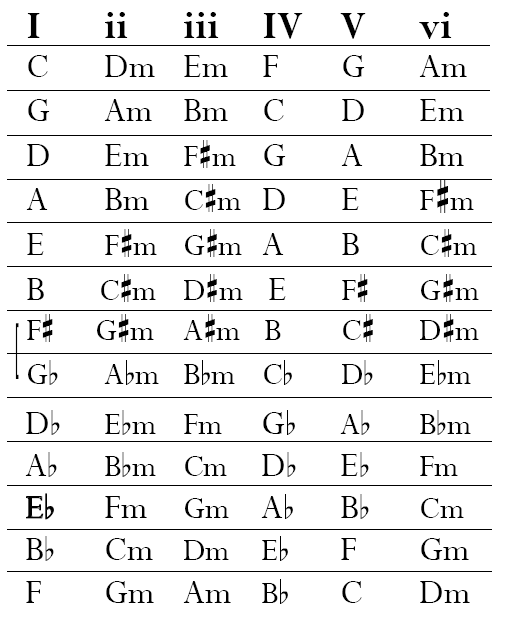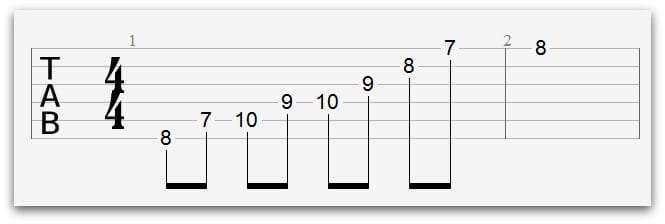Improvisation Challenge
Here is a backing track in the key of A major.
We’re going to improvise along with it using the A major scale pattern.
All you’re going to do here is, listen to the backing track, try out different notes from the scale and see how they come together to form a melody.
Give it a try.
Note that the aim here is not to simply play the notes of the scale in order. That would defeat the object.
What we want to do is mix the notes about so as they don’t sound like a scale, more like a melody or solo.
If you find a pattern of notes that sounds nice when you play it over and over, then you’ve just written a riff.
How to change the key of major scale patterns
Obviously not every song in the world is in A major.
So if we want to have the freedom to improvise in any song, we need to know how to change the key of the major scale pattern.
It’s fairly straight forward.
All we need is a basic grasp of the musical alphabet.
Here’s a handy diagram of ALL of the notes on the guitar:
Notice how the 5th fret on the low E string in this diagram is an A note?
That’s where our A major scale starts, isn’t it?
So to change the key of our major scale patterns, we can simply use this diagram to move our pattern up or down.
For example, let’s say we want the B major scale.
If you look at the diagram, you’ll notice that B is two frets along from A, so that’s how far up we need to move the pattern.
This is called transposing.
To learn more about guitar keys, go here: Guitar Keys – An Essential Guide
How do we know what key we want the scale to be in?
A scale pattern is not much use to us if we don’t know what key we need to play it in.
If a song has three major chords in it, we want to figure out which of them is chord 1 (or chord I, as it’s sometimes written in Roman numerals).
This is fairly straight forward.
Here’s a chord sequence:
| A |D | E | |
Which of these two chords are alphabetically next to one another?
That’s right. D and E.
Our chord 1 is the other chord.
In this case: A
So the key is A.
So the key of a song is the first chord in the song?
No. That’s a common misconception.
The first chord in the song can be chord 1, but it isn’t always.
For example, if the chords are:
| D | C |G | |
Which two chords are alphabetically next to one another?
That’s right. C and D.
So the other chord is G.
So the key is G.
NB: This method of figuring out the key only works with major chords, not minor chords.
If it helps, here is a diagram of all the major and minor chords in all the keys that you can refer to:

✅ Stop struggling. Start making music. ✅ Learn beginner-friendly versions of every chord. This is our most popular guide and it will improve your chord ability quickly! 😎 Get a custom guitar-learning plan here: Click here for GuitarMetrics™ Learn from the world's best guitar educators: Click here for our guitar coursesLearn 12 EASY beginner chords with our popular guide

Get your own personalised guitar-learning plan 🎸
World-Class Guitar Courses 🌎
Still struggling? Stick to pentatonics!
If you’re struggling to figure out the key despite having this method and the above chart to help you, you can always stick to the pentatonic scales we looked at earlier.
With pentatonic scales you can pick any chord from the song and match up the pattern with it.
Eg. If the chords are D, C and G like in the earlier example, you can use either the D, C or G major pentatonic scale.
Just make sure to match major pentatonics to major chords and minor pentatonics to minor chords.
Want to learn about minor pentatonics? Check out this article: Pentatonic Scale: An Essential Guide
Some bonus major scale patterns
If you’re feeling adventurous, you might like to give these patterns a try:
Major 7 arpeggio:
What we’re doing here is essentially only playing every other note of the major scale.
So we’re playing the 1st note (the root), the 3rd note, the 5th note and the 7th note. (The final note is just a repeat of the root note.)
We’re leaving out the 2nd note, the 4th note, the 6th note.
As the saying goes, less is more!
You’ll probably find the major 7 arpeggio has a very mysterious sound… or a very jazzy sound.
Three fingers per string scale pattern:
This pattern will sound identical to the intermediate pattern, but because it uses three fingers on each string, you’ll find it’s ideal for fast playing, especially if you just pick the first note on each string and play the other two as hammer-ons.
This example is in G.
Obviously for a pattern like this, our earlier one finger to a fret method of playing isn’t going to work.
The best thing to do is start each string with the 1st finger and end each string with the 4th finger.
For the notes imbetween, use either the 2nd or 3rd finger, depending on what’s nearest and easiest.
What Type of Guitarist Are You?
Take our 60-second quiz & get your results: Take The Quiz
Join the world's best online guitar school 🌎
- Get your own personalised guitar learning plan (customised just for YOU).
- World-class online guitar courses. Learn at your own pace.
- Community Campus & Learning Forum - A friendly community! Connect with our team & students. 😊
- Beginner Song library with chordsheets, tabs and tips. (Songs suitable for all levels!)
- Regular live streams, seminars and Q&A sessions - Learn from world-class guitar educators. Get all your questions answered!
Click here to learn more about National Guitar Academy membership 
Cool Guitar T-shirts 😎
Look cooler! Check out our merch: Click here to see our merch store
Want free guitar tips and video lessons delivered to your inbox?
Join over 250,000 other guitar learners and subscribe to our guitar-tips-by-email service. (It's free.)
We'll send you a series of lessons that will move you to the next level of your guitar journey.
Learn how everything fits together quickly, easily and effectively. We share ninja tips (for instant fun!) but also timeless fundamentals that will deepen your understanding.

Popular Lessons
How To Learn Guitar: An 11-Step Programme For Beginners
How To Choose The Perfect Beginner Guitar
More Cool Guitar Stuff
Learn about National Guitar Academy: About Us
Visit our YouTube channel for fun guitar videos.
Join us on Facebook for daily guitar tips.
Listen to our Learn Guitar Podcast for rapid guitar progress.
Check out our free chord lessons.
Where should we send it?
Get our best guitar tips & videos






